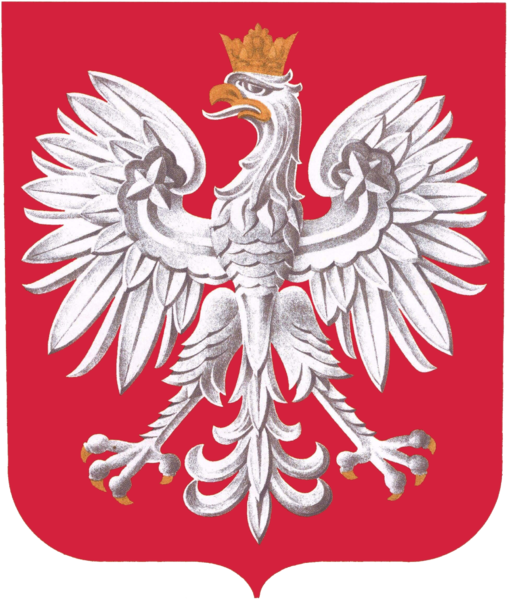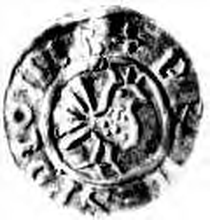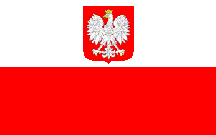Note: If an image ever fails to appear - refresh your page, it really is there
The White Eagle of Poland
by Chrystian Kretowicz and Peter Loeser
The White Eagle began as the emblem of the Polish royality, but over the centuries it has changed into a patriotic symbol for all Polish people. It now appears on official government seals, military flags, on government buildings, on Poland's currency and coins, on military and police uniforms, and in the free classrooms of today's democratic republic.
 The Polish "Orzel Bialy" (White Eagle) The Polish "Orzel Bialy" (White Eagle) The mythical story of Lech spotting a white eagle launching from the nest in the crown of a tree against the red background of the sky at sunset is, of course, just a story. There is no evidence of such a event whatsoever, but it would be foolish to discount it completely, as many Polish legends suggest a very strong affection to the white eagle on red symbol, very likely painted on the shields of the knights and warriors in service of the early Polish Princes and Kings. Later on, in the 12th century, Silesian knights were going to battle under a black eagle on a white or yellow field, but for the rest of Poland, the white eagle on red was surely predominant.
Poland (Principatum Polonić) became a Christian country under the rule of the Prince, Mieszko I, in 966 A.D.. Nothing is known about the symbolics
of this period, but the first, documented, image of an eagle appears on the denar minted by the son of Mieszko, Boleslaus the Brave (Chrobry) who was crowned the first king of Poland by the Holy Roman Emperor Otto III, in Gniezno, in 1025.
 Denar Eagle Coin 1000 Denar Eagle Coin 1000 Over the next 200 years Poland was divided into small principalities, each ruled individually by dukes of the Piast line. The White Eagle was retained by most of them, including even the dukes ruling Kraków, as personal coat-of-arms. This fact would later play an important part in the reunification of Poland.
|
|
|
War Banner of Przemysl II |
|
War Banner of Wladyslaw Jagiello |
That reunification took place with the coronation of King Przemysl II (Premyslas-Premislaus) in 1295. The first, documented, flag (war banner) comes from the time of his short rule. Przemysl II was crowned in 1295, and then assassinated in 1296. The new King's personal emblem was, however, the White Eagle, complete with a golden crown, golden beak, and golden claws.
In 1386, another great event occurred in the history of Poland. Wladyslaw Jagiello, the Grand Duke of Lithuania, accepted Christianity, married Jadwiga, the Queen of Poland, and was crowned King of Poland. Once again the White Eagle was to be found on the many banners and coat-of-arms of the day.
At the end of the 18th century, Poland lost its independence and was partitioned in three stages (1772, 1793 and 1795) by Russia, Prussia and Austria. The use of the White Eagle was forbidden and was replaced by the coats-of-arms of the partitioning monarchs. It was at this time that the White Eagle made its metamorposes from royal symbol to one of the people used during the insurrections of 1830 and 1863.
 National Poland State Flag since 1919 National Poland State Flag since 1919 In 1919, when Poland regained its independence at the end of World War I, the Sejm (parliament) immediately placed the crowned White Eagle on the national flag as the official state symbol. In 1927, it approved a new version of the design, the one which continues to be used to this day.
During World War II, the use of the White Eagle symbol was once again forbidden by both the Germans and Russians. Once again it became the symbol of the nation's struggle for independence. It was used by the Polish Underground Army and by the Polish Government and Armed Forces in Exile.
Poland would not regain its freedom at the end of World War II, because the Soviet Union imposed a Communist Regime on the nation and removed the crown from the restored White Eagle emblem, an action that angered the Polish people and underscored the country's loss of true idependence. When in 1989, the Solidarity movement overthrew the Communist regime, one of the first acts of the democratically elected Sejm was restoration of the White Eagle's crown.
| Top of Page | Return to "Flags of Poland" | Return to "Vexillological Essays and Chart Pages Menu" |
|